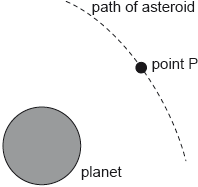| Date | November 2016 | Marks available | 5 | Reference code | 16N.2.HL.TZ0.7 |
| Level | Higher level | Paper | Paper 2 | Time zone | 0 - no time zone |
| Command term | Describe and Determine | Question number | 7 | Adapted from | N/A |
Question
Explain what is meant by the gravitational potential at the surface of a planet.
An unpowered projectile is fired vertically upwards into deep space from the surface of planet Venus. Assume that the gravitational effects of the Sun and the other planets are negligible.
The following data are available.
Mass of Venus = 4.87×1024 kg Radius of Venus = 6.05×106 m Mass of projectile = 3.50×103 kg Initial speed of projectile = 1.10×escape speed
(i) Determine the initial kinetic energy of the projectile.
(ii) Describe the subsequent motion of the projectile until it is effectively beyond the gravitational field of Venus.
Markscheme
the «gravitational» work done «by an external agent» per/on unit mass/kg
Allow definition in terms of reverse process of moving mass to infinity eg “work done on external agent by…”.
Allow “energy” as equivalent to “work done”
in moving a «small» mass from infinity to the «surface of» planet / to a point
N.B.: on SL paper Q5(a)(i) and (ii) is about “gravitational field”.
i
escape speed
Care with ECF from MP1.
v = «»
or 1.04×104«m s–1»
or «1.1 × 1.04 × 104 m s-1»= 1.14 × 104 «m s–1»
KE = «0.5 × 3500 × (1.1 × 1.04 × 104 m s–1)2 =» 2.27×1011 «J»
Award [1 max] for omission of 1.1 – leads to 1.88×1011 m s-1.
Award [2] for a bald correct answer.
ii
Velocity/speed decreases / projectile slows down «at decreasing rate»
«magnitude of» deceleration decreases «at decreasing rate»
Mention of deceleration scores MP1 automatically.
velocity becomes constant/non-zero
OR
deceleration tends to zero
Accept “negative acceleration” for “deceleration”.
Must see “velocity” not “speed” for MP3.


